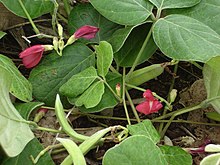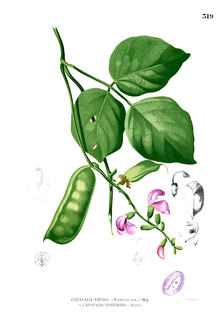Canavalia
| Canavalia | |
|---|---|

| |
| Canavalia sericea | |
| Scientific classification | |
| Kingdom: | Plantae |
| Clade: | Tracheophytes |
| Clade: | Angiosperms |
| Clade: | Eudicots |
| Clade: | Rosids |
| Order: | Fabales |
| Family: | Fabaceae |
| Subfamily: | Faboideae |
| Tribe: | Diocleae |
| Genus: | Canavalia DC.[1] |
| Species[1] | |
|
62; see text | |
| Synonyms[1] | |
| |
Canavalia is a genus of plants in the legume family (Fabaceae) that comprises approximately 62 species of tropical vines.[1] Members of the genus are commonly known as jack-beans. It has a pantropical distribution.[1]
The species of Canavalia endemic to the Hawaiian Islands were named ʻāwikiwiki by the Native Hawaiians. The name translates to "the very quick one"[2] and comes from the Hawaiian word for "fast". The genus name is derived from the Malabar word for the species, kavavali, which means "forest climber."[3]
Uses[edit]
Several species are valued legume crops, including common jack-bean (C. ensiformis), sword bean (C. gladiata) and C. cathartica. At least the first makes a beneficial weed- and pathogen-suppressing living mulch.[4] The common jack-bean is also a source of the lectin concanavalin A, which is used as a reagent in glycoprotein biochemistry and immunology. The jack-bean is also a common source of purified urease enzyme used in scientific research.
The bay bean (Canavalia rosea) is supposedly mildly psychoactive when smoked, and is used in tobacco substitutes.
Ecology[edit]
Some animals have adaptations to the defensive chemicals of jack-beans. Caterpillars such as that of the two-barred flasher (Astraptes fulgerator) are sometimes found on Canavalia. The plant pathogenic ascomycete fungus Mycosphaerella canavaliae was described from a jack-bean. Introduced herbivores have wreaked havoc on Canavalia on the Hawaiian Islands and made some nearly extinct; it may be that these lost their chemical defenses because no herbivorous mammals existed in their range until introduced by humans. The usually bright pea-flowers are pollinated by insects such as solitary bees and carpenter bees such as Xylocopa confusa.
History[edit]
The genus name Canavalia was, as recently as 1913, known as Canavali.[5]
Diversity[edit]


Species include:[6]
- Canavalia acuminata Rose
- Canavalia africana Dunn
- Canavalia altipendula (Piper) Standl.
- Canavalia aurita J.D. Sauer
- Canavalia bicarinata Standl.
- Canavalia boliviana Piper
- Canavalia bonariensis Lindl.
- Canavalia brasiliensis Mart. ex Benth.[7] – Barbicou-bean, feijão-bravo do Ceará (Brazil)
- Canavalia campylocarpa Piper
- Canavalia cathartica Thouars (syn. C. virosa (Roxb.) Wight & Arn.)
- Canavalia centralis H.St.John
- Canavalia concinna J.D.Sauer
- Canavalia dolichothyrsa G.P. Lewis
- Canavalia dura J.D. Sauer
- Canavalia ensiformis (L.) DC. – common jack-bean, giant stock-bean, gotani-bean, horse-bean, seaside-bean, wonder-bean, feijão-de-porco (Brazil)
- Canavalia eurycarpa Piper
- Canavalia forbesii H.St.John
- Canavalia galeata (Gaudich.) Vogel[8] (Oʻahu)[9]
- Canavalia glabra (M. Martens & Galeotti) J.D.Sauer
- Canavalia gladiata (Jacq.) DC. – sword bean, scimitar-bean
- Canavalia grandiflora Benth.
- Canavalia haleakalaensis H.St.John
- Canavalia hawaiiensis O.Deg., I.Deg. & J.D.Sauer[8]
- Canavalia hirsutissima J.D. Sauer
- Canavalia iaoensis H.St.John
- Canavalia kauaiensis J.D.Sauer[8]
- Canavalia kauensis H.St.John
- Canavalia lineata (Thunb.) DC.
- Canavalia macrobotrys Merr.
- Canavalia macropleura Piper
- Canavalia madagascariensis J.D.Sauer
- Canavalia makahaensis H.St.John
- Canavalia mattogrossensis (Barb. Rodr.) Malme
- Canavalia matudae J.D. Sauer
- Canavalia microsperma Urb.
- Canavalia mollis Wight & Arn.
- Canavalia molokaiensis O.Deg., I.Deg. & J.D.Sauer[8] – Molokaʻi jack-bean
- Canavalia munroi (O.Deg. & I.Deg.) H.St.John
- Canavalia napaliensis H.St.John[8] – Mākaha Valley jack-bean
- Canavalia nitida (Cav.) Piper – Cathie's bean
- Canavalia nualoloensis H.St.John
- Canavalia obidensis Ducke
- Canavalia oxyphylla Standl. & L.O. Williams
- Canavalia palmeri (Piper) Standl.
- Canavalia papuana Merr. & L.M. Perry
- Canavalia parviflora Benth.
- Canavalia peninsularis H.St.John
- Canavalia picta Benth.
- Canavalia piperi Killip & J.F.Macbr.
- Canavalia plagiosperma Piper – giant bean, oblique-seed jack-bean
- Canavalia pubescens Hook. & Arn.[8] – lavafield jack-bean
- Canavalia raiateensis J.W. Moore
- Canavalia ramosii J.D. Sauer
- Canavalia regalis Piper & Dunn
- Canavalia rockii H.St.John
- Canavalia rosea (Sw.) DC. – bay bean, beach-bean, coastal jack-bean, fire-bean, Mackenzie-bean
- Canavalia rutilans DC.
- Canavalia sanguinea H.St.John
- Canavalia saueri Fantz
- Canavalia septentrionalis J.D. Sauer
- Canavalia sericea A. Gray
- Canavalia sericophylla Ducke
- Canavalia stenophylla H.St.John
- Canavalia villosa Benth.
Formerly placed here[edit]
- Dysolobium grande (Wall. ex Benth.) Prain (as C. grandis (Wall. ex Benth.) Kurz)[7]
Gallery[edit]
See also[edit]
- Thierry Bardini - researched Venezuelan jack-bean agriculture early in his career
References[edit]
- ^ a b c d e Canavalia DC. Plants of the World Online. Retrieved 14 August 2023.
- ^ Pukui, M. K., et al. (1992): New Pocket Hawaiian Dictionary with a Concise Grammars and Given Names in Hawaiian. University of Hawaii PRess, Honolulu. ISBN 0-8248-1392-8
- ^ Austin, D. F. (2004). Florida Ethnobotany. CRC Press. p. 161. ISBN 978-0-8493-2332-4.
- ^ Caamal-Maldonado, J. A.; et al. (2001). "The use of allelopathic legume cover and mulch species for weed control in cropping systems". Agronomy Journal. 93: 27–36. doi:10.2134/agronj2001.93127x. Archived from the original on 2014-05-25. Retrieved 2013-08-29.
- ^ Piper, C. V. 1913. "The Jack Bean and the Sword Bean." USDA Bureau of Plant Industry, Circular. No. 110. p. 29-36
- ^ Genus Canavalia. Archived 2014-05-17 at the Wayback Machine International Legume Database & Information Service (ILDIS). Version 10.01, November 2005. Retrieved 17 December 2007.
- ^ a b "GRIN Species Records of Canavalia". Germplasm Resources Information Network. United States Department of Agriculture. Archived from the original on 2009-01-20. Retrieved 2010-12-03.
- ^ a b c d e f "ʻawikiwiki, puakauhi". Hawaiian Ethnobotany Database. Bernice P. Bishop Museum. Archived from the original on 2007-07-02. Retrieved 2009-03-26.
- ^ "Canavalia galeata". Hawaiian Native Plant Propagation Database. University of Hawaiʻi at Mānoa. Retrieved 2009-03-26.





